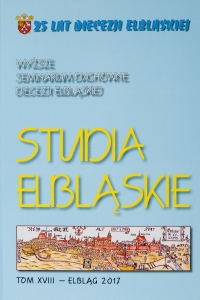Protestanci, menonici i Żydzi w diecezji pomezańskiej (XVII – XVIII w.) w protokołach wizytacyjnych parafii
Protestants, Mennonites and Jews in the Pomesanian diocese (17th–18th century) in the parish visitation reports
Author(s): Jan WiśniewskiSubject(s): Christian Theology and Religion, History, Cultural history, History of Church(es), Local History / Microhistory, Theology and Religion
Published by: Wyższe Seminarium Duchowne Diecezji Elbląskiej w Elblągu
Keywords: Protestants; Mennonites; Jews; houses of prayer; predicants; conflicts; Catholics defending against the spread of Protestantism; Pomezania
Summary/Abstract: In the modern period (seventeenth – eighteenth centuries) the Diocese of Pomesania lay within Royal Prussia (excluding Elbląg and Warmia), whereas Catholics were subject to the Crown since 1466. Still, they were unable to resist effectively against the pressure of Protestantism, especially in the cities of Prussia. Protestants gained religious privileges as early as 1543, but there was no cooperation with the Protestants in this region until after the end of the 16th century. The region witnesses the influx of various Protestant denominations, including Mennonites (Anabaptists), Calvinists and Lutherans. Groups of Mennonites came to Żuławy in the 1540s and 1550s (ca. 1526? to the area of Malbork), and in 1642 Władysław IV Vasa granted them a privilege to freely pursue their religious practices. The governor of Sztumfounded a Calvinist community in Jordanki, but it declined upon his death in 1675. The most numerous religious group were Lutherans, who settled down on royal and private estates andthen established their communities in Jordanki, Jasna and Rodowo, that is outside Royal Prussia. There was a small group of Jews, who traded in Sztum despite the prohibition issued bythe Teutonic Knights and were present in the village of Węgry in the mid-eighteenth century. Proponents of Lutheranism found temporary place of residence in the mansions of wealthy farmers and when they gained a group of worshipers, they would organise a prayer house and a school, where the preacher and the teacher lived. The third stage of their development was collecting funds to build their own church. However, they had to obtain the consent of the bishop to take up their pastoral activity, such consent being issued in the absence of the opposition from the Catholic priest. The local parish priest would lose „souls” and the income from tithes and Christmas offerings, although dissenters were under a parish obligation to make fees for services (baptism, wedding, funeral). To defend the position of the Catholic Church in the Diocese of Pomesania, the bishop did not agree to the construction of a church, house of prayer or the activities of the „heretic” pastor and teacher. Nevertheless, with the support of their followers, they strengthened their presence in Catholic parishes. There were conflicts between Catholics and Protestants in the seventeenth and eighteenth centuries, but they must be considered incidental, although Catholic priests did react differently. Many of them were admonished and encouraged by the bishop to be more vigilant and careful of the faithful, to see to it that children and youth are taught in a Catholic school andoppose any attempts by dissenters to organize work among Catholics. Nevertheless, residents of individual parishes did not oppose to Lutherans and Mennonites being buried in Catholiccemeteries. What is more, the so-called „Żuławy custom” was developed here, which was a model of coexistence between faithful of both religions. It was finally accepted by thebishop, who recommended that a separate part of the cemetery be allotted to them at the appropriate distance from the church. Followers of other denominations also achieved quitea lot as far as building their churches is concerned. More specifically, they built them at the following locations: Barcice (prayer house), Boręty, Dzierzgoń (chapel), Gnojewo, Jasna,Jordanki, Kaczynos, Kończewice, Kraśniewo, Krzyżanowo (chapel), Lasowice, Lichnowy, Lipinki, Lisewo (chapel), Łoza, Malbork, Marynowy, Myszewo, Niedźwiedzica, Nowa Cerkiew, Nowy Staw, Ostaszewo, Orłowo, Stalewo, Stara Kościelnica, Stare Pole, Świerki,Szawałd, Sztum, Tujsk, Tulice, Żuławki. Mennonites, on the other hand, who were defended by the Catholics because of their hard work and honesty, owned houses of prayer, among others, in: Barcice, Lubieszewo, Marynowy, Niedźwiedzica, Nowy Dwór [Gd.], Orłowskie Pole and Stogi. They were also used by residents of other villages.
Journal: Studia Elbląskie
- Issue Year: 2017
- Issue No: 18
- Page Range: 37-88
- Page Count: 52
- Language: Polish

